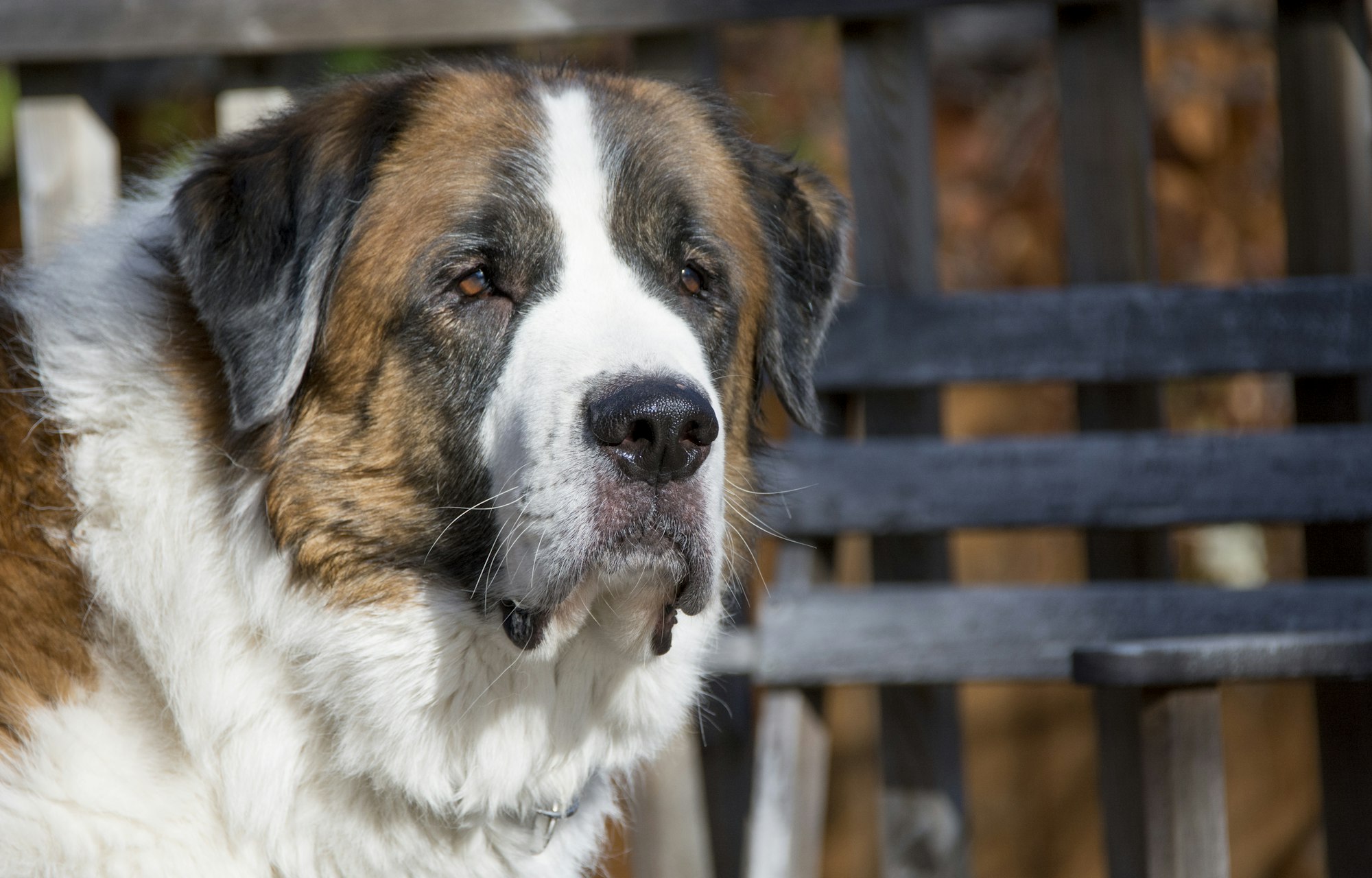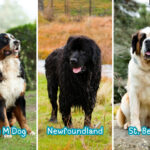 4 May
4 MayBernese Mountain Dogs vs St. Bernard Dog Breed
Choosing the right dog breed ensures a happy coexistence between you and your new furry friend. This article compares two beloved giants: Bernese Mountain Dogs and St. Bernard Dogs. Whether you’re drawn to the friendly demeanor of the Bernese or the noble presence of a St. Bernard, understanding their distinct backgrounds, characteristics, and needs will help you decide which breed might be the best fit for your lifestyle.
We’ll cover everything from their origins to their temperament and grooming needs to ensure you make an informed choice. So, if you’re trying to figure out whether a Bernese Mountain Dog or a St. Bernard Dog is right for you, you’re in the perfect place to learn more.
Bernese Mountain Dogs vs St. Bernard Dogs: Which Is Right For You?
The main difference between Bernese Mountain Dogs and St. Bernard Dogs lies in their size and grooming needs. Bernese Mountain Dogs are large, typically weighing up to 115 pounds, and require significant grooming due to their thick, shedding coat. On the other hand, St. Bernard Dogs are even larger, often weighing up to 180 pounds, and their grooming involves managing fur and drool. Both breeds are known for their friendly and affectionate nature, making them excellent family pets. Still, potential owners should consider their living space and ability to meet the dogs’ exercise and health care needs.
| Feature | Bernese Mountain Dog | St. Bernard Dog | Ideal Owner |
|---|---|---|---|
| Size | Large; up to 115 lbs | Very large; up to 180 lbs | Bernese: Those who can handle a large dog. St. Bernard: Those who can handle a very large dog. |
| Appearance | Tri-color (black, white, and rust) | Mostly white with red or brown marks | No specific preference based on appearance. |
| Temperament | Friendly, affectionate, loyal | Gentle, friendly, watchful | Both: Families looking for a loyal pet. |
| Exercise Needs | Moderate | Moderate but less than Bernese | Bernese: Active individuals or families. St. Bernard: Less active individuals or families. |
| Training | Intelligent but can be stubborn | Very intelligent, eager to please | Both: Those willing to invest in training. |
| Health | Prone to certain genetic disorders | Prone to more serious health issues | Bernese: Prepared for potential health issues. St. Bernard: Prepared for intensive health care needs. |
| Lifespan | About 7-10 years | About 8-10 years | No specific preference based on lifespan. |
| Grooming Needs | High due to shedding and thick coat | High due to size and drooling | Both: Those ready to commit to regular grooming. |
| Family Compatibility | Excellent with children and other pets | Excellent with children, good with pets | Both: Families with children and possibly other pets. |
| Living Conditions | Needs space to move, tolerates cold well | Needs more space, tolerates cold well | Both: Those with adequate living space, preferably with a yard. |
| Cost of Ownership | High due to health care and grooming | Higher due to size-related costs | Both: Those financially ready for a large dog’s expenses. |
Choosing between a Bernese Mountain Dog and a St. Bernard Dog ultimately depends on your capacity to handle these aspects. Bernese are slightly more manageable in size, while St. Bernards require more intensive grooming and space.
Origin of Bernese Mountain Dogs
The Bernese Mountain Dog hails from the Swiss Alps, specifically the canton of Bern, where they were originally used as farm dogs. Their history dates back over 2,000 years, descending from mastiff-type dogs brought into Switzerland by the Romans.
Throughout the centuries, Bernese Mountain Dogs have been valued for their versatility as draft animals, herders, and guardians of farmyards and homes. The breed’s strength and gentle temperament made it excellent for pulling carts and driving cattle and reliable companions for farmers and their families.

Origin of St. Bernard Dogs
St. Bernard Dogs originated in the Swiss Alps as well but are named after the Great St. Bernard Hospice, a traveler’s refuge on the often treacherous Great St. Bernard Pass between Switzerland and Italy. Monks established the hospice in the 11th century, and by the 17th century, the monks were breeding these dogs to assist in rescue operations for lost or injured travelers in the snowy mountains.
Known initially as “Saint Dogs” or “Barry Dogs” after a famous dog named Barry who reportedly saved over 40 lives, they became renowned for their incredible sense of direction and resistance to cold, which were vital traits for alpine rescues. Their legendary rescue efforts have cemented their status as one of the most heroic canine breeds.
Bernese Mountain Dogs vs St. Bernard: Who Should Choose Which Breed?
Deciding between a Bernese Mountain Dog and a St. Bernard involves considering your lifestyle, family setup, and personal preferences for dog care and activity levels.
Here’s a detailed breakdown to help determine which breed might be the best fit for you:
Bernese Mountain Dog
- Active Families: Bernese Mountain Dogs thrive in environments where they can be active and engaged. A Bernese would be a perfect match if your family enjoys outdoor activities and is looking for a companion on walks, hikes, or yard play.
- Owners with Time for Grooming: Bernese Mountain Dogs require regular grooming due to their thick, long coats. If you enjoy or don’t mind the grooming process and can commit to it, this breed will fit well into your routine.
- Households with Other Pets: Bernese are known for their friendly nature and generally get along well with other pets. They can be a great addition to a multi-pet household.
- Cooler Climates: Bernese Mountain Dogs’ thick coat suits them well for cooler climates. They are comfortable in cold weather, which is something to consider if you live in a region with harsh winters.

St. Bernard Dog
- Families with Space: St. Bernards need ample space to move around comfortably due to their very large size. Homes with large yards or access to open spaces are ideal for this breed.
- Less Active Individuals: While St. Bernards need regular exercise, they are generally less active than Bernese Mountain Dogs. If you prefer leisurely walks instead of vigorous daily activities, a St. Bernard might be more your speed.
- Owners Prepared for Drooling: St. Bernards are known for drooling, especially after eating or drinking. If you’re comfortable managing this trait, you’ll find a gentle and affectionate companion in a St. Bernard.
- Owners Committed to Intensive Grooming: In addition to their size, the grooming requirements for St. Bernards are significant due to their drooling and the need to maintain their coat and skin health. If you are prepared for a high level of grooming commitment, consider a St. Bernard.
Special Considerations
- Financial Considerations: Given their size and potential health issues, both breeds can incur significant expenses, from food to veterinary care. Prospective owners should be financially prepared for the cost of owning a large breed dog.
- Long-term Commitment: Both Bernese Mountain Dogs and St. Bernards have relatively short lifespans with some breed-specific health concerns. Potential owners should consider their ability to commit to caring for a large dog that may develop health issues as it ages.
Choosing between a Bernese Mountain Dog and a St. Bernard Dog largely depends on matching the breed’s characteristics and needs with your circumstances and ability to meet those needs.
Both breeds offer immense love and loyalty, making them wonderful additions to the right home.




